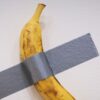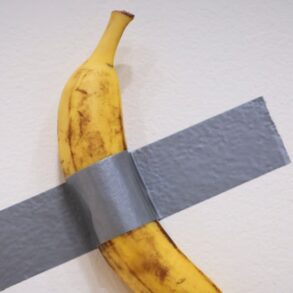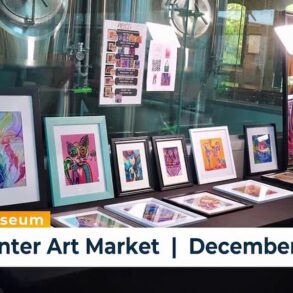Editor’s Note: This story originally appeared in On Balance, the ARTnews newsletter about the art market and beyond. Sign up here to receive it every Wednesday.
While the press and the fair-going public may be captivated by the art world’s simmering rivalry between Paris and London, dealers at Frieze London seemed unconcerned. There were more than enough visitors on the fair’s two VIP days to keep them busy.
“Frankly I’m bored by the Paris versus London talk, especially because a number of dealers are choosing to do both,” New York dealer Alexander Gray told ARTnews.
Two dealers at galleries with a global presence told ARTnews they felt that the focus on whether Paris may overtake London as art’s European capital misses the forest for the trees. The real problem is the costs associated with the fair—including shipping, transportation, and other expenses that have risen dramatically since the Covid-19 pandemic—and the challenge of getting enough material to feed the beast.
“It’s become a situation where galleries struggle to even fill the booth,” one of the dealers, who has locations in both New York and London, said. “Unless you’re working in the Hauser & Wirth model, where you scoop up every artist that has a pulse, it’s getting harder and harder every year.”
“The struggle is very real,” Javier Peres, of Berlin-based Peres Projects, said. “The cost of participating in these fairs, or even running a gallery, is not reflected in the market right now.”
To get an idea of the situation for galleries, Peres added, look at the auction houses. (In September art market analysts Michael Moses and Jianping Mei released a report calling the Spring 2024 auction season the worst performance of the century so far. Their report followed ones that auction sales in the first half of 2024 were down 22 percent and 25 percent for Christie’s and Sotheby’s, respectively.)
“People often forget that the auction house’s job is to sell things that are actually sellable. They can turn things away, we can’t. So, imagine how the galleries are doing,” Peres said.
Still, of course, there was talk of London-Paris rivalry, perhaps because Art Basel is finally moving into the Grand Palais.
Neil Wenman, Hauser & Wirth’s global creative director, pushed back on the idea that Art Basel Paris, which starts October 18, was muscling Frieze out of the limelight.
“The fairs are two different beasts,” he said. “London is such a creative place where art is made, art is written about, art is curated, and Frieze puts a giant spotlight on the city’s brilliance. Paris is different. It’s not as contemporary, it’s more classical—and it’s also doing super well.”
Wenman said that Hauser & Wirth curated a “more experimental, more educational” booth for this year’s Frieze London, seemingly in a bid to counter the UK’s contracting art market.
“Because of the market’s situation, we decided to give people the chance to discover something new rather than just put on a huge commercial display,” Wenman said.
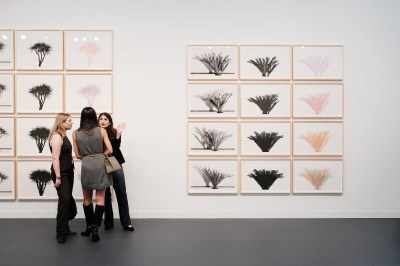
People visit the Hauser & Wirth booth at the Frieze London art fair in London.
Photo by Linda Nylind; Courtesy Frieze
The gallery’s booth is decked out with works from American artist Charles Gaines’s “Shadow” series. By the end of the VIP days, five “Shadows” works had sold for a combined total of $915,000. Across Regent’s Park, at Frieze Masters, Hauser & Wirth’s operation reported the biggest-ticket sales so far. The gallery sold Arshile Gorky’s The Opaque (1947) for $8.5 million, Édouard Manet’s Pelouse du champ de courses à Longchamp (1865) for just under $5 million, and Elle danse (1948) by Francis Picabia for $4 million. Not a bad start to the fair.
Back at Frieze’s contemporary quarter, David Zwirner sold two works by Lisa Yuskavage for $2.2 million and $160,000, and a couple of paintings by the 95-year-old Japanese artist Yayoi Kusama for $670,000 and $720,000. Bringing Kusama to the Zwirner booth is well-timed; she has a much-publicized show at London’s Victoria Miro gallery, and recently installed two public sculptures in the city.
On the first preview day, Lehmann Maupin sold 11 paintings by British artist Billy Childish to collectors from multiple countries. Some of the paintings were made, start to finish, at the fair as visitors looked on, iPhones outstretched to capture the “performance” on video or post it to social media. The works, according to the gallery, sold for between $50,000 to $100,000 each. The idea was slightly twee and worked in tandem with the misty-river-countryside aesthetic of both Childish and his paintings.
One of the first galleries to report a sold-out booth was Stephen Friedman, who parted with 12 large-scale works by Britain’s Caroline Walker and Clare Woods to collectors in the UK, Europe, the US, and Asia. They sold for between $45,000 and $230,000.
Frieze’s Reconfigured Layout Gives Smaller Galleries a Leg Up
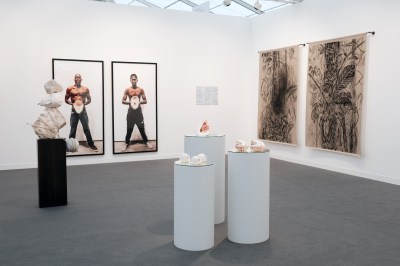
Mor charpentier’s presentation at Frieze London 2024.
Linda Nylind/Courtesy of Frieze
Frieze London this year comes with a new layout that largely consists of two broad aisles that lead from the single point of entry and exit toward what many consider to be the main attractions—mega-galleries like Pace, Gagosian, Hauser & Wirth, and David Zwirner. But unlike in previous years, where those giants of art commerce stood front and center under the Frieze tent, the new layout put the megas at the end of the path, which in reality is the fair’s midway point. To get out, you have to go the way you came, increasing the likelihood that something at one of the small or midsize galleries might grab and hold your attention.
“Ultimately, we are here so people get that first ‘wow’ of discovery, then the how, which dealers provide, then another wow when it all comes together in a kind of circulation of discovery that benefits both the visitors and the dealers,” Gray said. Gray recently moved into a space in New York’s Tribeca neighborhood, where many younger galleries are clustered. “The new layout really benefits that cycle of discovery.”
An art adviser, who asked to remain anonymous, told ARTnews that this year’s fair is proving positive for works priced in the low to mid-range, spurred on by the reconfigured layout.
Arthur Gruson, a director from mor charpentier gallery, which has spaces in Paris and Bogotá, is one of the smaller galleries set up near Frieze’s entrance. He told ARTnews that the new blueprint—and the subsequent increased footfall—helped him sell half of the booth’s 20-odd kworks on Wednesday, priced from $12,000 to $30,000.
Christie’s Channels Fair’s Spending, But Sotheby’s Falls Short

A gallery assistant poses with Balloon Monkey (Blue) by Jeff Koons during a photocall for the 20/21 Century London Evening Sale at Christie’s in London on October 3, 2024.
AFP via Getty Images
Sales at Frieze may have trumped expectations on the first day, despite the ongoing doomsday art market narrative, but Sotheby’s evening sale of contemporary art that evening failed to catch the same wave. It brought in $49.2 million (plus fees), a whisker over the $47.5 million low estimate, with David Hockney’s L’Arbois, Sainte-Maxime (1968) headlining the auction after sailing past its high estimate of $13 million and selling for $17.2 million.
It should be noted that Hockney was also Pace’s top seller on Wednesday at Frieze, according to the gallery, which said that 25th July – 7th August 2021, Rain on the Pond (2021) was the most expensive work moved on the first day. (Pace did not disclose a price for its Hockney.)
Emma Baker, Sotheby’s head of contemporary evening sales, remained upbeat, telling ARTnews after the auction that she was “excited to once again feel that incomparable energy” that Frieze brings. The fair’s global crowd was reflected by the night’s winning bidders. “Given the international flair of the fair, it is particularly exciting to note that the Bridget Riley has been won by a collector in Asia, and that the Anselm Kiefer has gone to a collector in India,” she added. Those works sold for $2.4 million and $1.3 million, respectively.
Christie’s 20th/21st century evening auction, though, managed to tune into Frieze’s relative spendthrift and totalled $107.1 million (plus fees). The result was still short of the $133 million high estimate, though. Lucian Freud’s Ria, Naked Portrait (2006/7) sold for $15.4 million and Jeff Koons’s Balloon Monkey(Blue), from 2006–13, went for almost $10 million.
“We sourced fresh-to-the-market works that resonated with collectors globally and priced them fairly,” Keith Gill, Christie’s vice chairman of 20th/21st century art and head of Impressionist and modern art in Europe, told ARTnews. “This evening’s results demonstrate that London draws international collectors attracted by the energy and diversity of what’s on offer during Frieze Week.”
Paris Calling
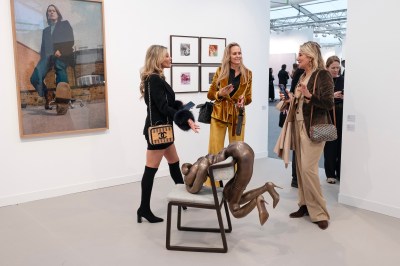
Sadie Coles’ presentation at Frieze London 2024.
Linda Nylind/Courtesy of Frieze
Over 30 of the galleries at Frieze are preparing to set up shop at Art Basel Paris next week, including top dealers like White Cube, Gagosian, and Thaddaeus Ropac.
London-based Sadie Coles, another powerful dealer who is doing both fairs, is planning on differentiating her Frieze London and Art Basel Paris booths, she told ARTnews, saying that the fairs have different demographics and tastes. “The collectors in Paris are more local, and many people are buying for their apartments,” she said, adding that her Paris offerings will be smaller as a result.
Goodman Gallery, one of the key galleries representing artists from the African continent, is also participating in both fairs. At Frieze, the gallery brought a broad cross section of the 51 artists it represents, including both well-established and emerging figures. William Kentridge, Carrie Mae Weems, and Atta Kwami were among those with works represented. For Paris, however, the gallery said it plans to bring a more focused selection that includes Ghada Amer and Kapwani Kiwanga, who is representing Canada at this year’s Venice Biennale.
“It’s important for us to showcase as many of the divergent voices that exist on the continent,” Anthony Dawson, a director at Goodman’s Cape Town gallery, told ARTnews when asked why the gallery chose to participate in both fairs.
Emmanuel Perrotin, of the eponymous mega-gallery with spaces in Paris, Hong Kong, New York, Seoul, Tokyo, Shanghai, and Los Angeles, told ARTnews that his team has been less discerning when deciding which works go to Frieze and which to Art Basel Paris.
“The crowd in Paris will be just as international as they are here in London,” he said. Will Perrotin gallery’s works be smaller next week? Apparently not. “A lot of people have big apartments in France,” he added.

